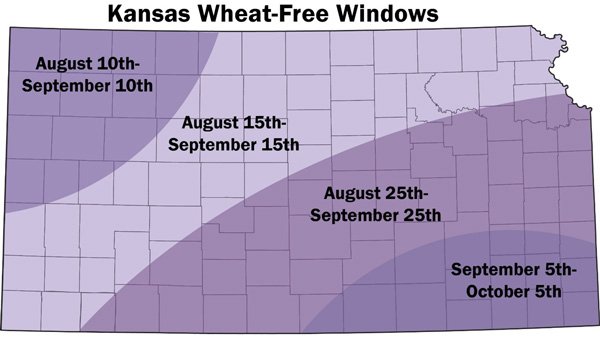This article is the third in a multi-week K-State agronomy series on wheat streak mosaic complex management to address the 2025 outbreak. In week 1, was the introduction of a Kansas Wheat-Free Windows recommendation and discussion on herbicide recommendations for volunteer wheat. In week 2, discussion of the role of alternate hosts in the landscape. This week, the discussion will be on variety selection as part of an integrated management program for wheat streak mosaic.
• Week 1: (https://bit.ly/4eSVKgP) Wheat-free windows and herbicide recommendations
• Week 2: (https://bit.ly/3GIY2Ta) The role of alternative host crops
• Week 3: Variety selection for wheat streak complex management
In the first article of this series, the recommendation for wheat-free windows was discussed. These windows include periods 30 days prior to the start of the optimal winter wheat planting window by zone in Kansas. As the wheat curl mite is a community pest, coordinated breaks in volunteer wheat and other cereals will have the highest likelihood of lowering local and statewide mite levels moving into our 2025 optimal winter wheat planting date periods. Volunteer wheat that emerges after the fall crop is already established poses a lower risk as a green bridge and can be thought of in a similar way as the fall crop. Fall wheat planted early, during wheat-free windows, risks bridging wheat curl mite to the fall-established crop.
Here are some important considerations for achieving success with wheat-free windows:
• All volunteer wheat should be terminated and completely dead prior to the start of your regional wheat-free window.
• Where possible, the fall wheat crop should not be planted until the end of the wheat-free window.
• Other winter cereals (such as rye and triticale) should not be planted during this period as they can serve as a “bridge” for the curl mites to move to fall-established wheat.
• A regional “break” in the volunteer wheat green bridge will allow for wheat curl mites to die off prior to the start of the optimal wheat planting window.
• Volunteer wheat that emerges after this period is of less concern, as it will be emerging at a similar time as the fall-established winter wheat crop.
• Success is dependent on coordinated efforts in communities.
Management with genetic resistance: Another tool in the toolbox - in addition to controlling volunteer wheat, genetic resistance is also an important component of a good integrated pest management strategy for wheat streak mosaic complex control. It’s important to note that while some varieties provide partial protection against the wheat streak complex, there is no silver bullet variety that will work in all scenarios. That is, all commercial varieties will be symptomatic under some conditions, but the degree of yield loss to the virus complex will vary between varieties.
As a reminder, yield loss to wheat streak complex is highly influenced by timing of infection, composition of viruses, and variety choice.
We know that fall infections and infections that occur in earlier stages of wheat development (prior to jointing) can result in the highest levels of yield loss. Infections that occur after the flag leaf and booting growth stages generally result in lower levels of yield loss. It should be noted that infections can occur in the fall and remain “dormant” in the plants until the weather warms in the spring. This is why we can sometimes see symptoms come on suddenly when the weather warms in the spring.
In addition to the timing of infection, the composition of viruses in a given field can impact final yield losses. Infections with more than one virus (WSMV + TriMV, for example) can result in synergistic yield losses. It was common to see infections with two or more viruses in Kansas in 2025.
When we think about variety resistance in the context of wheat streak mosaic complex, there are two main types. Resistance to the virus and resistance to the mite.
When it comes to resistance to the virus, several genes have been described (wsm1, wsm2, and wsm3). The gene wsm2 is most widely available in Kansas varieties, including KS Territory (red), KS Mako (red), KS Bill Snyder (red), KS Dallas (red), KS Hamilton (red), Guardian (red), Oakley CL (red), Joe (white), and KS Big Bow (white). This resistance gene can help with severe wheat streak mosaic virus infections, but has key limitations. For example:
• This gene is effective against wheat streak mosaic virus but not against Triticum mosaic virus or High Plains wheat mosaic virus. In 2025, many mixed infections were detected with more than one of the viruses in the complex. So, it was not uncommon to see a variety with wsm2 appear symptomatic in the field. In many of these cases, Triticum mosaic virus was detected in the sample.
• The resistance conferred by wsm2 can also become less effective at high temperatures, although resistance in KS Dallas and KS Hamilton seems to endure greater temperatures before breaking down (~ 70º F). The resistance is much less effective if wheat is planted too early for grazing or if high temperatures persist into October. KS Silverado (white) also has temperature-sensitive resistance to wheat streak mosaic, although from a different source than wsm2.
In addition, there are a handful of varieties with resistance to the wheat curl mite (cmc4), including Guardian, Canvas, TAM 112, Byrd, Avery, Langin, Kivari AX, KS Western Star, Whistler, Crescent AX, Incline AX, Fortify SF, TAM 115, TAM 204, and T158. These varieties remain susceptible to viral diseases, but they generally slow the development of the mite populations in the fall. This resistance can help reduce the risk of severe disease, but will not provide enough protection if wheat is planted in close proximity to volunteer wheat or other hosts infested with large populations of the curl mites and virus.
Central versus western Kansas: Location matters - unfortunately, many of these varieties are adapted to Western Kansas and may not be the best options for production systems in the central corridor. Some central Kansas-adapted varieties, including Rockstar, AP Prolific, SY Wolverine, LCS Photon AX, LCS Helix AX, and LCS Julep, tolerate WSMV infection better than others. It should be noted that, for all the reasons mentioned above, these varieties will still appear symptomatic under high disease pressure. KS Mako is a new release out of the K-State Manhattan breeding program that is adapted for the central corridor of the state and carries the wsm2 gene. These varieties will still show symptoms of WSMV but may yield better than other varieties that are more susceptible.
More information on variety selection can be found here: MF991 KS. Wheat Variety Guide https://bookstore.ksre.ksu.edu/pubs/MF991.pdf. A newer version of this publication will be released in the coming weeks.
Information provided by Kelsey Andersen Onofre, Extension Wheat Pathologist.
Stacy Campbell is an Agriculture and Natural Resources agent for Cottonwood Extension District. Email him at scampbel@ksu.eduor call the Hays office, 785-628-9430.





